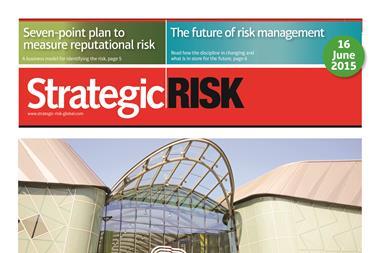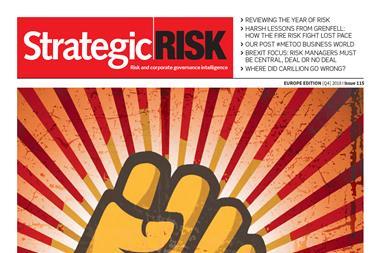Collating information on claims and ‘near misses’ can improve your risk profile. Simon Challis reports
As the philosopher Francis Bacon said, ‘knowledge is power’. Some companies are putting this maxim into action by collecting operational data to enable them to take decisive action to reduce their exposures – and save themselves large amounts of money.
Companies are increasingly turning to sophisticated systems that capture huge amounts of loss data to give them an intimate knowledge of their risk profile. With companies setting higher self-insured limits, they can no longer rely on insurers to collect this kind of information on their behalf. They must do it for themselves – and collecting it will help them to work out whether they are getting value for money from their carriers.
‘In the current climate we are finding that more and more companies are asking us for technical analysis, simply because with limited resources they are looking harder at what they pay out,’ says Kartina Thomson, a managing consultant in Marsh’s
modelling, analysis and design team. ‘One of the areas where they can save money is on insurance or risk management. Companies are keen on having the information to allow them to come to a clear decision.’
Accurate and consistent
It is not simply the quantity, but also the quality of the data they collect that is vital. Firms must ensure they get the right information in the right form to enable them to accurately model their risk profile.
‘The data has to be accurate and consistent, and historical data is as important to us as current data,’ says Jayne Coleman, liability and claims manager at UK retail chain Sainsbury. ‘I have to make sure that it isn’t rubbish in, rubbish out… our claims handling team can be the best in the world, but if their data is incorrect it’s no use to me.’
Information on ‘near misses’ – incidents that could have resulted in serious injury or death to an employee or customer, or damage to property – is as important as data on actual losses or claims. It can be used to work out the likelihood of that event actually occurring in future, which is vital in projecting how the company’s risk profile may change.
Another retailer, Arcadia, collects data on thousands of incidents every year, from the most minor injuries through to major incidents. It uses a specialised
telephone helpline, staffed by third-party operators who are trained to collect the information the company needs for its risk control systems. If an incident occurs within one of its stores the risk management team and its firm of loss adjusters will know about it within the hour.
‘The quality of data is important but the speed of decision-making is the key to everything,’ says Colin Campbell, Arcadia’s head of risk management. ‘It allows us to make very early interventions into accidents that do occur, identify those that may become claims and determine how to deal with them.’
Value for money
For those willing to spend the time and money to build such data collection systems, there are substantial rewards to be reaped in enabling them to demonstrate to investors how their risk management efforts are saving the company’s money.
‘This is important in boosting their profile with investors, particularly when rating agencies now focus more attention on standards of risk management when assigning their credit ratings,’ says Thomson.
Campbell admits there is a balance to be struck between how much this approach costs and how much it saves the business. ‘These people and systems cost money to hire and run, but we are saving hundreds of thousands of pounds as a result of having them.’
Recovery
With many corporations choosing to retain more risk on their own balance sheet, it is increasingly likely that hefty losses will fall within their self-insured limit.
Most companies will have set their deductible so that no loss will be big enough to blow a hole in their balance sheet. But what if a hefty loss was not caused by your employees, but was the fault of one of your business partners? Despite having sophisticated and highly effective risk management programmes, many businesses do not have a process for deciding whether to pursue third parties for recovery of an uninsured loss.
‘The danger is that the individual budget holder or finance director, wherever he sits in the organisation, simply makes the call on whether anything is done about it,’ says Andy King, EMEA practice leader at Marsh Risk Consulting’s forensic accounting and claims services. As a result, companies may miss out on recovering substantial amounts at a time when cash flow is tight.
It could simply be that systems already in place to investigate and log the cause of losses for risk management databases can be tweaked to ask the question ‘Can we recover this loss?’ But pursuing a contractor or supplier with whom you work closely for money can be a tricky business.
‘We are fairly aggressive in seeking recovery,
but some claims will be settled on a relationship basis,’ Arcadia’s Campbell says. ‘Whatever we do
will be a commercial decision based on the
overall business.’
For Sainsburys, a commercial relationship would never stand in the way of recovering money from a negligent third party, says Coleman. ‘If they were a major contractor that would only make me more determined, because we have a contractual
relationship with them.’
Some companies find it easier to use a third party to conduct the negotiations at arm’s length rather than risk falling out with a key supplier. Marsh has acted for clients to formulate claims and negotiate a settlement with business partners. ‘Because we don’t have a stake in that relationship they can maintain their business relationship without carrying losses for which they are not responsible,’ King says.
He adds: ‘No one wants a hole in their budget or their financial statements as a result of a loss that was the consequence of the action of a third party. But no one is going to write a cheque for you unless you take the time to pursue a recovery and hold someone responsible for it.’
Postscript
Simon Challis is a freelance writer



















